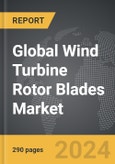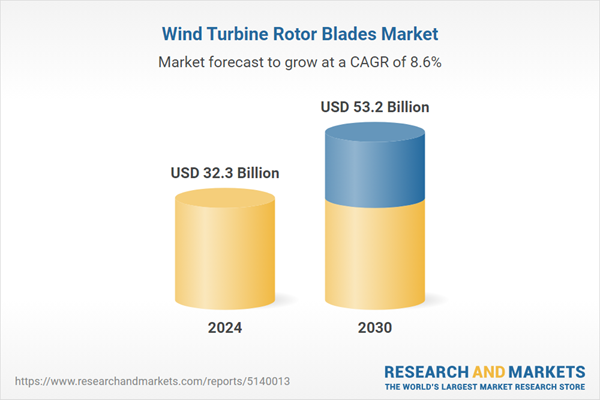Global Wind Turbine Rotor Blades Market - Key Trends & Drivers Summarized
Wind turbine rotor blades are a crucial component of wind turbines, transforming wind energy into mechanical power to generate electricity. The design and material of the blades are pivotal for the efficiency and performance of a wind turbine. Rotor blades are the wing like rotating structures that are the core components for the functioning of the wind turbine and are meticulously designed to maximize the optimal functioning in all wind conditions and speeds and in conditions where presence of dirt on the blades is inevitable due to scanty rainfall.Glass fiber reinforced plastics (GRP) are ideally suited and economical for large turbine rotor blades hence dominate the large installations relegating Kevlar (aramid) and carbon fibers to the mid and smaller installations. Moreover, smaller turbines still utilize aluminum alloys and steel for rotor blades despite the concerns of metal fatigue and weight issues. Research is underway to discover new reinforcing material for rotor blades.
Technological advancements in wind turbine rotor blades have significantly enhanced their performance and efficiency. Innovations in material science have led to the development of more robust and lighter composite materials, which improve blade lifespan and reduce maintenance requirements. Advanced manufacturing techniques such as automated fiber placement and 3D printing are being utilized to produce blades with greater precision and consistency. Additionally, the integration of smart sensors and IoT technology in rotor blades enables real-time monitoring of blade conditions, allowing for predictive maintenance and optimization of turbine performance. Research is also being conducted into biomimetic designs, inspired by nature, to develop blades that are quieter and more efficient.
The growth in the wind turbine rotor blades market is driven by several factors. Advances in material science and manufacturing technologies have led to the production of longer, more efficient blades that can capture more wind energy. The global push towards renewable energy sources and the increasing installation of wind farms, both onshore and offshore, are significantly boosting the demand for high-performance rotor blades. Government policies and incentives promoting the adoption of green energy are also propelling market growth. Furthermore, the trend towards larger and more powerful wind turbines necessitates the development of advanced rotor blades that can handle greater loads and operate efficiently under diverse environmental conditions. The expansion of wind energy infrastructure in emerging economies, where there is a growing emphasis on sustainable energy solutions, is also driving demand. Additionally, ongoing research and development efforts aimed at improving blade design and materials are expected to support the continued growth of the market by enabling the production of superior rotor blades at lower costs.
Report Scope
The report analyzes the Wind Turbine Rotor Blades market, presented in terms of units. The analysis covers the key segments and geographic regions outlined below.Segments: Blade Length (Above 60 Meters Length, 45 - 60 Meters Length, Below 45 Meters Length); Material (Glass Fiber Material, Carbon Fiber Material); Application (On-Shore Application, Off-Shore Application).
Geographic Regions/Countries: World; USA; Canada; Japan; China; Europe; France; Germany; Italy; UK; Spain; Russia; Rest of Europe; Asia-Pacific; Australia; India; South Korea; Rest of Asia-Pacific; Latin America; Argentina; Brazil; Mexico; Rest of Latin America; Middle East; Iran; Israel; Saudi Arabia; UAE; Rest of Middle East; Africa.
Key Insights:
- Market Growth: Understand the significant growth trajectory of the Above 60 Meters Length segment, which is expected to reach US$15.7 Billion by 2030 with a CAGR of a 9.3%. The 45 - 60 Meters Length segment is also set to grow at 8.5% CAGR over the analysis period.
- Regional Analysis: Gain insights into the U.S. market, valued at $6.3 Billion in 2024, and China, forecasted to grow at an impressive 10.4% CAGR to reach $10.8 Billion by 2030. Discover growth trends in other key regions, including Japan, Canada, Germany, and the Asia-Pacific.
Why You Should Buy This Report:
- Detailed Market Analysis: Access a thorough analysis of the Global Wind Turbine Rotor Blades Market, covering all major geographic regions and market segments.
- Competitive Insights: Get an overview of the competitive landscape, including the market presence of major players across different geographies.
- Future Trends and Drivers: Understand the key trends and drivers shaping the future of the Global Wind Turbine Rotor Blades Market.
- Actionable Insights: Benefit from actionable insights that can help you identify new revenue opportunities and make strategic business decisions.
Key Questions Answered:
- How is the Global Wind Turbine Rotor Blades Market expected to evolve by 2030?
- What are the main drivers and restraints affecting the market?
- Which market segments will grow the most over the forecast period?
- How will market shares for different regions and segments change by 2030?
- Who are the leading players in the market, and what are their prospects?
Report Features:
- Comprehensive Market Data: Independent analysis of annual sales and market forecasts in US$ Million from 2024 to 2030.
- In-Depth Regional Analysis: Detailed insights into key markets, including the U.S., China, Japan, Canada, Europe, Asia-Pacific, Latin America, Middle East, and Africa.
- Company Profiles: Coverage of players such as Aeris Energy, Enercon GmbH, Lianyungang Zhongfu Lianzhong Composites Group Co. Ltd., LM Wind Power, Nordex SE and more.
- Complimentary Updates: Receive free report updates for one year to keep you informed of the latest market developments.
Some of the 30 companies featured in this Wind Turbine Rotor Blades market report include:
- Aeris Energy
- Enercon GmbH
- Lianyungang Zhongfu Lianzhong Composites Group Co. Ltd.
- LM Wind Power
- Nordex SE
- Siemens Gamesa Renewable Energy SA
- Suloz Energy Ltd.
- TPI Composites Inc.
- Vestas Wind Systems A/S
Tariff Impact Analysis: Key Insights for 2025
Global tariff negotiations across 180+ countries are reshaping supply chains, costs, and competitiveness. This report reflects the latest developments as of April 2025 and incorporates forward-looking insights into the market outlook.The analysts continuously track trade developments worldwide, drawing insights from leading global economists and over 200 industry and policy institutions, including think tanks, trade organizations, and national economic advisory bodies. This intelligence is integrated into forecasting models to provide timely, data-driven analysis of emerging risks and opportunities.
What’s Included in This Edition:
- Tariff-adjusted market forecasts by region and segment
- Analysis of cost and supply chain implications by sourcing and trade exposure
- Strategic insights into geographic shifts
Buyers receive a free July 2025 update with:
- Finalized tariff impacts and new trade agreement effects
- Updated projections reflecting global sourcing and cost shifts
- Expanded country-specific coverage across the industry
Table of Contents
Companies Mentioned (Partial List)
A selection of companies mentioned in this report includes, but is not limited to:
- Aeris Energy
- Enercon GmbH
- Lianyungang Zhongfu Lianzhong Composites Group Co. Ltd.
- LM Wind Power
- Nordex SE
- Siemens Gamesa Renewable Energy SA
- Suloz Energy Ltd.
- TPI Composites Inc.
- Vestas Wind Systems A/S
Table Information
| Report Attribute | Details |
|---|---|
| No. of Pages | 310 |
| Published | April 2025 |
| Forecast Period | 2024 - 2030 |
| Estimated Market Value ( USD | $ 32.3 Billion |
| Forecasted Market Value ( USD | $ 53.2 Billion |
| Compound Annual Growth Rate | 8.6% |
| Regions Covered | Global |









